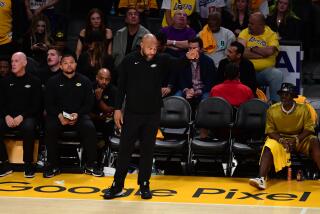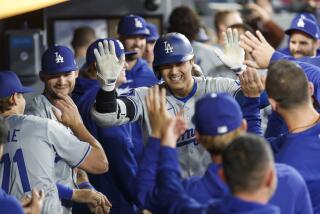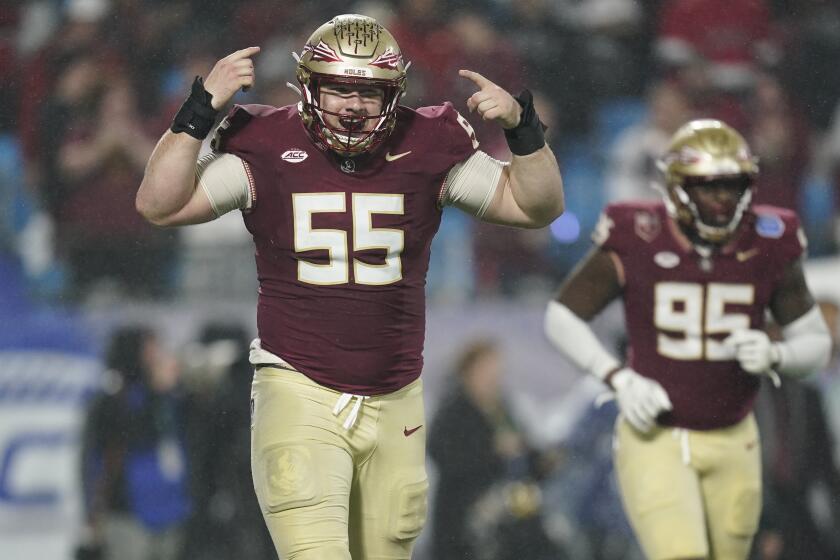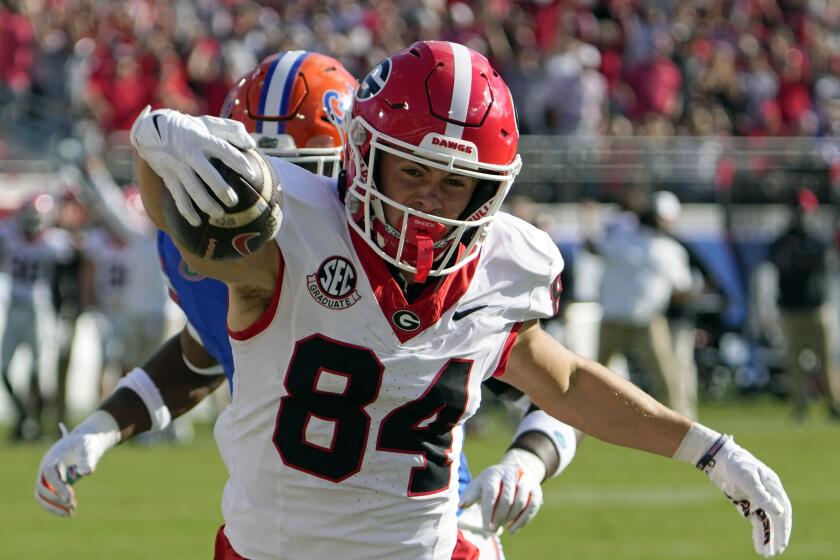Illini Fighting to Keep Their Chief Mascot
As this college town prepared for the University of Illinois football season’s opener Saturday, the giddy chatter about the team’s new coach and the hottest tailgate parties was overshadowed by a sense of mourning.
This is probably the last year Chief Illiniwek -- the symbol of all things sports on this Big Ten campus -- will dance.
Since 1926, one student each year has been selected to dress in buckskins and face paint and perform a three-minute athletic dance during halftime at Illini football and basketball games and other sporting events.
Last year, the National Collegiate Athletic Assn. found the Chief and his dancing a “hostile and abusive” use of Native American imagery. After two failed appeals -- and months of university staff’s trying to find a way to save the icon that is stamped on everything from university stationery to La-Z-Boy loveseats -- the sense around town is that the school is finally throwing in the towel.
Heightening angst was a report last week in the Chicago Sun-Times that quoted unnamed university sources saying the school plans to drop the mascot by this spring, at the end of basketball season.
That move would allow the university to host postseason NCAA events, such as championship games, which could generate both publicity and sales revenue from visiting fans to Champaign, about 130 miles south of Chicago.
University officials have remained relatively mum about the mascot’s fate, saying only that the school’s Board of Trustees continues to meet and discuss the matter. Earlier, the university succeeded in preserving the use of the names “Illini” and “Fighting Illini” for its teams.
The NCAA has told the school, “If you want to host post-season games, you have to make this change,” said university spokesman Tom Hardy.
Bob Williams, a spokesman for the NCAA, said, “It’s Illinois’ decision whether to keep the Chief, just like it’s our decision to say where our tournaments can and can’t be held.”
Illinois is not alone in its dilemma. Last year, the university, along with 17 other schools, was placed on a list of institutions banned from hosting post-season NCAA events -- until they changed their mascot and eradicated use of its image.
The ruling came as part of a practice among schools, at both the high school and college level, to stop using references and imagery of Native Americans as mascots. Some schools have already made the transition: Southeastern Oklahoma State University, formerly the Savages, has become the Savage Storm.
Though the move drew praise from groups that oppose such depictions, it also stirred controversy when some schools on the list -- such as the Florida State Seminoles -- were allowed to keep their mascots after local tribes gave their support.
Leaders of the Peoria Tribe of Indians of Oklahoma, which has members descended from tribes that no longer exist in Illinois, have been pushing for the school to stop using Chief Illiniwek for several years.
“It takes so long to change racism, and this is racist,” said Cindy La Marr, executive director of Capitol Area Indian Resources in Sacramento. She served on the steering committee of the California-based Alliance Against Racial Mascots.
“I knew Illinois would fight,” La Marr said. “I was just surprised that they were so adamant that they were right.”
Indeed, eradicating school traditions is seen by many college sports fans as begging for bad luck.
At the University of Iowa, for decades visiting football players have been assigned a pink locker room inside Kinnick Stadium. When the school wanted to make the room even more Barbie-esque, critics pushed for a gender-neutral color.
The mere suggestion of changing the paint sparked an outcry from Hawkeye fans around the world, who sent thousands of e-mails begging to keep the pink. (The school ultimately agreed, and painted everything from the urinals to the lockers a shade of Pepto-Bismol pink.)
Depending on whom you talk to in Champaign, the NCAA is either a courageous voice for racial tolerance or a misguided bureaucracy trying to destroy all that is revered in college sports.
For seven Saturdays this year -- as maple trees line the streets in shades of burnt gold and emerald green, and the air is filled with eye-stinging smoke from neighborhood barbecues -- tens of thousands of people will gather at Memorial Stadium and celebrate their passion for the game.
This weekend, they spoke longingly of the old days, of legendary player Harold “Red” Grange’s 95-yard kickoff return for a touchdown against Michigan in 1924, and of their 1984 trip to the Rose Bowl. (UCLA beat them, 45-9.)
“My grandson is a kicker with the Fighting Illini, and I don’t want them to do anything that could jinx them this year,” said Phil E. Turney, 72, of Oquawka, Ill. “What’s it hurt to keep things the way they are? If they change, it could bring more bad than good.”
On Saturday, the last-ditch hopes for keeping the Chief could be seen all across campus.
Alumnus Lance Landeck proudly pointed to the handmade sign -- “Keep the Chief!” -- hanging next to his barbecue at his family’s tailgate party.
“I grew up going to games here, watching the Chief,” said Landeck, 38, an elementary school principal in Newman, Ill. “My daughter was just a few days old when she came to her first game and saw the Chief. I’d want my grandkids to be able to do the same.”
All around, fans donned bright orange T-shirts with the icon’s face printed on the back. Across the lawn next to the stadium, children put on feathered headdresses.
One young woman, wearing blue hot pants, had the phrase “Save the Chief” emblazoned across her backside.
More to Read
Get our high school sports newsletter
Prep Rally is devoted to the SoCal high school sports experience, bringing you scores, stories and a behind-the-scenes look at what makes prep sports so popular.
You may occasionally receive promotional content from the Los Angeles Times.






